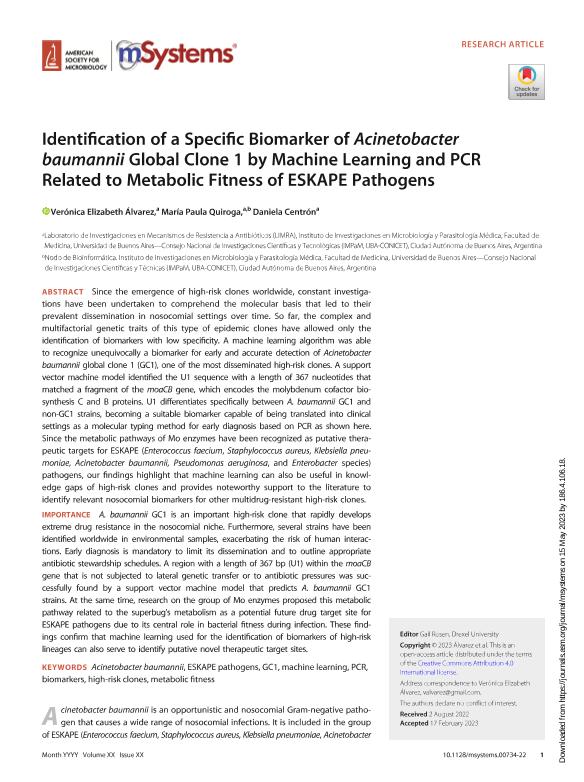Mostrar el registro sencillo del ítem
dc.contributor.author
Alvarez, Verónica Elizabeth

dc.contributor.author
Quiroga, María Paula

dc.contributor.author
Centrón, Daniela
dc.date.available
2024-02-20T15:01:52Z
dc.date.issued
2023-02
dc.identifier.citation
Alvarez, Verónica Elizabeth; Quiroga, María Paula; Centrón, Daniela; Identification of a Specific Biomarker of Acinetobacter baumannii Global Clone 1 by Machine Learning and PCR Related to Metabolic Fitness of ESKAPE Pathogens; American Society for Microbiology; mSystems; 8; 3; 2-2023; 1-20
dc.identifier.uri
http://hdl.handle.net/11336/227652
dc.description.abstract
Since the emergence of high-risk clones worldwide, constant investigations have been undertaken to comprehend the molecular basis that led to their prevalent dissemination in nosocomial settings over time. So far, the complex and multifactorial genetic traits of this type of epidemic clones have allowed only the identification of biomarkers with low specificity. A machine learning algorithm was able to recognize unequivocally a biomarker for early and accurate detection of Acinetobacter baumannii global clone 1 (GC1), one of the most disseminated high-risk clones. A support vector machine model identified the U1 sequence with a length of 367 nucleotides that matched a fragment of the moaCB gene, which encodes the molybdenum cofactor biosynthesis C and B proteins. U1 differentiates specifically between A. baumannii GC1 and non-GC1 strains, becoming a suitable biomarker capable of being translated into clinical settings as a molecular typing method for early diagnosis based on PCR as shown here. Since the metabolic pathways of Mo enzymes have been recognized as putative therapeutic targets for ESKAPE (Enterococcus faecium, Staphylococcus aureus, Klebsiella pneumoniae, Acinetobacter baumannii, Pseudomonas aeruginosa, and Enterobacter species) pathogens, our findings highlight that machine learning can also be useful in knowledge gaps of high-risk clones and provides noteworthy support to the literature to identify relevant nosocomial biomarkers for other multidrug-resistant high-risk clones. IMPORTANCE A. baumannii GC1 is an important high-risk clone that rapidly develops extreme drug resistance in the nosocomial niche. Furthermore, several strains have been identified worldwide in environmental samples, exacerbating the risk of human interactions. Early diagnosis is mandatory to limit its dissemination and to outline appropriate antibiotic stewardship schedules. A region with a length of 367 bp (U1) within the moaCB gene that is not subjected to lateral genetic transfer or to antibiotic pressures was successfully found by a support vector machine model that predicts A. baumannii GC1 strains. At the same time, research on the group of Mo enzymes proposed this metabolic pathway related to the superbug's metabolism as a potential future drug target site for ESKAPE pathogens due to its central role in bacterial fitness during infection. These findings confirm that machine learning used for the identification of biomarkers of high-risk lineages can also serve to identify putative novel therapeutic target sites.
dc.format
application/pdf
dc.language.iso
eng
dc.publisher
American Society for Microbiology
dc.rights
info:eu-repo/semantics/openAccess
dc.rights.uri
https://creativecommons.org/licenses/by-nc-sa/2.5/ar/
dc.subject
ACINETOBACTER BAUMANNII
dc.subject
BIOMARKERS
dc.subject
ESKAPE PATHOGENS
dc.subject
GC1
dc.subject
HIGH-RISK CLONES
dc.subject
MACHINE LEARNING
dc.subject
METABOLIC FITNESS
dc.subject
PCR
dc.subject.classification
Biología Celular, Microbiología

dc.subject.classification
Ciencias Biológicas

dc.subject.classification
CIENCIAS NATURALES Y EXACTAS

dc.subject.classification
Ciencias de la Información y Bioinformática

dc.subject.classification
Ciencias de la Computación e Información

dc.subject.classification
CIENCIAS NATURALES Y EXACTAS

dc.title
Identification of a Specific Biomarker of Acinetobacter baumannii Global Clone 1 by Machine Learning and PCR Related to Metabolic Fitness of ESKAPE Pathogens
dc.type
info:eu-repo/semantics/article
dc.type
info:ar-repo/semantics/artículo
dc.type
info:eu-repo/semantics/publishedVersion
dc.date.updated
2024-02-20T13:21:46Z
dc.identifier.eissn
2379-5077
dc.journal.volume
8
dc.journal.number
3
dc.journal.pagination
1-20
dc.journal.pais
Estados Unidos

dc.journal.ciudad
Washington
dc.description.fil
Fil: Alvarez, Verónica Elizabeth. Consejo Nacional de Investigaciones Científicas y Técnicas. Oficina de Coordinación Administrativa Houssay. Instituto de Investigaciones en Microbiología y Parasitología Médica. Universidad de Buenos Aires. Facultad de Medicina. Instituto de Investigaciones en Microbiología y Parasitología Médica; Argentina
dc.description.fil
Fil: Quiroga, María Paula. Consejo Nacional de Investigaciones Científicas y Técnicas. Oficina de Coordinación Administrativa Houssay. Instituto de Investigaciones en Microbiología y Parasitología Médica. Universidad de Buenos Aires. Facultad de Medicina. Instituto de Investigaciones en Microbiología y Parasitología Médica; Argentina
dc.description.fil
Fil: Centrón, Daniela. Consejo Nacional de Investigaciones Científicas y Técnicas. Oficina de Coordinación Administrativa Houssay. Instituto de Investigaciones en Microbiología y Parasitología Médica. Universidad de Buenos Aires. Facultad de Medicina. Instituto de Investigaciones en Microbiología y Parasitología Médica; Argentina
dc.journal.title
mSystems
dc.relation.alternativeid
info:eu-repo/semantics/altIdentifier/doi/https://doi.org/10.1128/msystems.00734-22
dc.relation.alternativeid
info:eu-repo/semantics/altIdentifier/url/https://journals.asm.org/doi/10.1128/msystems.00734-22
Archivos asociados
